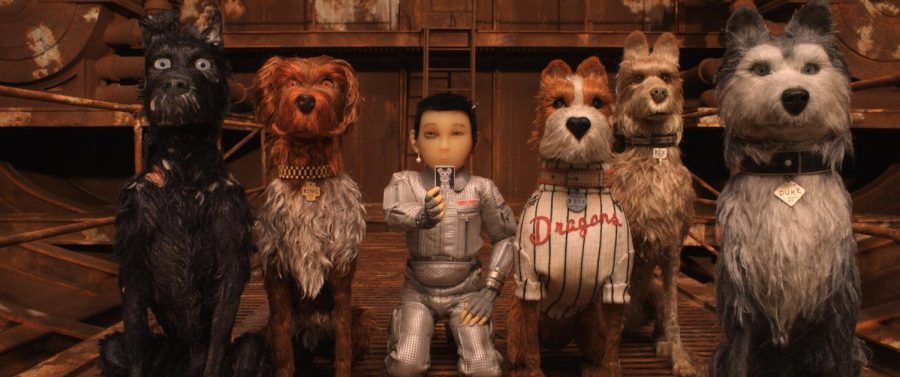Anderson creates whimsical ‘Isle of Dogs’
May 3, 2018
This piece was originally published in the April 20, 2018 issue of the Review.
Wes Anderson’s whimsical stop-motion genre-bending adventure “Isle of Dogs” begins with an on-screen message in both Japanese and English informing audience members that “all barks have been rendered into English.”
Anderson (’87) is perhaps best known at St. John’s for his 1998 film “Rushmore,” which was filmed on campus. “Isle of Dogs” marks his return to the big screen following “The Grand Budapest Hotel” (2014), a four-time Academy-Award winner and his highest grossing film to date.
In 2009, Anderson directed “Fantastic Mr. Fox”, his first film using stop-motion animation.
In an interview with The Review, Anderson discussed his latest film, his inspirations and, of course, “Rushmore.”
Anderson wanted to return to animation after his last two films were live-action, the aforementioned “The Grand Budapest Hotel” and “Moonrise Kingdom” (2012).
“This particular story seemed suited to this medium and might have been very difficult to do any other way.”
When read quickly, the title of his latest film sounds like “I love dogs,” but the storyline is not as lighthearted as that charming pun may lead one to believe. While “Fantastic Mr. Fox” received a family-friendly PG rating, “Isle of Dogs” is rated PG-13 for graphic images including one dog biting off another’s ear and a gruesome stop-motion kidney transplant.
“Isle of Dogs” is set in a dystopian Japan 20 years in the future, where the fictional Megasaki City is led by dictatorial Mayor Kobayashi, latest ruler in a dynasty of cat lovers who have a long-standing grudge against dogs. The villains give evil decrees while stroking cats in their laps while giant Orwellian posters of the mayor paper the city.
The film hinges on the decision to deport all dogs to Trash Island in order to prevent the spread of canine flu and snout fever. Mayor Kobayashi’s ward, a 12-year-old boy named Atari, builds a plane and flies to Trash Island in search of his bodyguard dog Spots. He is aided in his quest by his “a pack of scary, indestructible alpha dogs” who are stranded on the island.
Meanwhile, on the mainland, an American foreign exchange student at a middle school student newspaper tries to uncover the government conspiracy behind the canine flu outbreak. Like other Anderson films, the story is divided into distinct chapters and studded with flashbacks and non-sequential scenes.
The film features a star-studded cast complete with many frequent Anderson collaborators, including Bill Murray, Frances McDormand and Jeff Goldblum. Oscar-nominated director Greta Gerwig and musician Yoko Ono also have parts in the ensemble cast. Jason Schwartzman, the star of “Rushmore,” is one of four credited screenwriters.
According to Anderson, the contribution of the animators is especially important.
Choosing animators in stop-motion is very much like casting,” Anderson said. “Each one brings their unique skills and personality.”
The film heavily references Japanese culture, from the initial exposition taking the form of a traditional fable and shoji screens in the background. Much of the Japanese dialogue is not translated — the audience is expected to understand the emotional cues through facial expressions and tone of voice. In addition to the mandatory indie-folk song present in every Anderson movie, Taiko drums pound away in the background of many scenes. The score was composed by two-time Oscar winner Alexandre Desplat (“The Shape of Water” and “The Grand Budapest Hotel”).
Anderson credited “Neon Genesis Evangelion” and the films of Japanese directors Akira Kurosawa and Hiyao Miyazaki as inspirations for “Isle of Dogs.” The visual style also draws on the ukiyo-e prints of Hiroshige and Hokusai, whose “The Great Wave off Kanagawa” is visually parodied several times in the film.
Anderson’s attention to detail is as prevalent as it has been in previous films, especially in the dynamic animation. Materials such as cotton and sugar were used in the dogs’ sneezes, and foam mixed in a blender created leaves on trees. An astounding 240 sets were created for “Isle of Dogs,” characteristic of Anderson, who utilized 535 puppets in “Fantastic Mr. Fox” and had over 3,000 Mendl’s pastry boxes created for “The Grand Budapest Hotel.”
While Anderson enjoyed his return to stop-motion filmmaking, he considers the style of his films secondary to the story.
“It is more about the stories than the style — some way to bring the characters to life, to make interesting scenes, to try any possible way to create something unexpected and new.”
In closing, we asked Anderson what he would likely be doing if he had not become a filmmaker.
“Maybe I might have tried to become an architect.”






